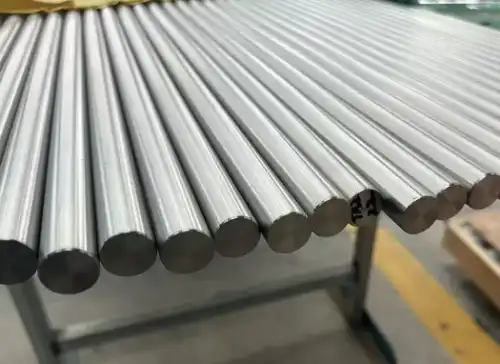The thermal conductivity of titanium rods and titanium alloy rods is low, which will cause a great temperature difference between the surface and the inner layer during hot extrusion. When the temperature of the extrusion barrel is 400 degrees, the temperature difference can reach 200~250 degrees. Under the combined influence of suction strengthening and a large temperature difference in the section of the billet, the metal on the surface and the center of the billet produces very different strength properties and plastic properties, which will cause very uneven deformation during the extrusion process, and produce large additional tensile stress in the surface layer, which becomes the source of cracks and cracks on the surface of the extruded product. The hot extrusion process of titanium rods and titanium alloy rods is more complicated than that of aluminum alloys, copper alloys, and even steel, which is determined by the special physical and chemical properties of titanium rods and titanium alloy rods.

The study of industrial titanium alloy metal flow dynamics shows that the flow behavior of the metal varies greatly in the temperature zone corresponding to the different phase states of each alloy. Therefore, one of the main factors affecting the extrusion flow characteristics of titanium rods and titanium alloy rods is the billet heating temperature determines the metal phase change state. Compared with extrusion at the temperature of the p phase region, the metal flow is more uniform when extruding at the temperature of the a or a+P phase region. It is very difficult to obtain high surface quality of extruded products. So far, lubricants must be used in the extrusion process of titanium alloy rods. The main reason is that titanium will form a fusible eutectic with the iron-based or nickel-based alloy mold material at 980 degrees and 1030 degrees, which will cause severe mold wear.
The main factors affecting metal flow during extrusion:
1. Extrusion method: reverse extrusion has a more uniform metal flow than forward extrusion, cold extrusion has a more uniform metal flow than hot extrusion, and lubricated extrusion has a more uniform metal flow than unlubricated extrusion. The influence of the extrusion method is achieved through the change of friction conditions.
2. Extrusion speed: As the extrusion speed increases, the unevenness of metal flow increases.
3. Extrusion temperature: When the extrusion temperature increases and the deformation resistance of the billet decreases, the uneven flow of metal increases. During the extrusion process, if the heating temperature of the extrusion barrel and the mold is too low, and the metal temperature difference between the outer layer and the center layer is large, the unevenness of metal flow increases. The better the thermal conductivity of the metal, the more uniform the temperature distribution on the end face of the ingot.
4. Metal strength: When other conditions are the same, the higher the metal strength, the more uniform the metal flow.
5. Die angle: The larger the die angle (i.e. the angle between the die end face and the center axis), the more uneven the metal flow. When a multi-hole die is used for extrusion, the die holes are arranged reasonably, and the metal flow tends to be uniform.
6. Deformation degree: If the deformation degree is too large or too small, the metal flow is uneven.











